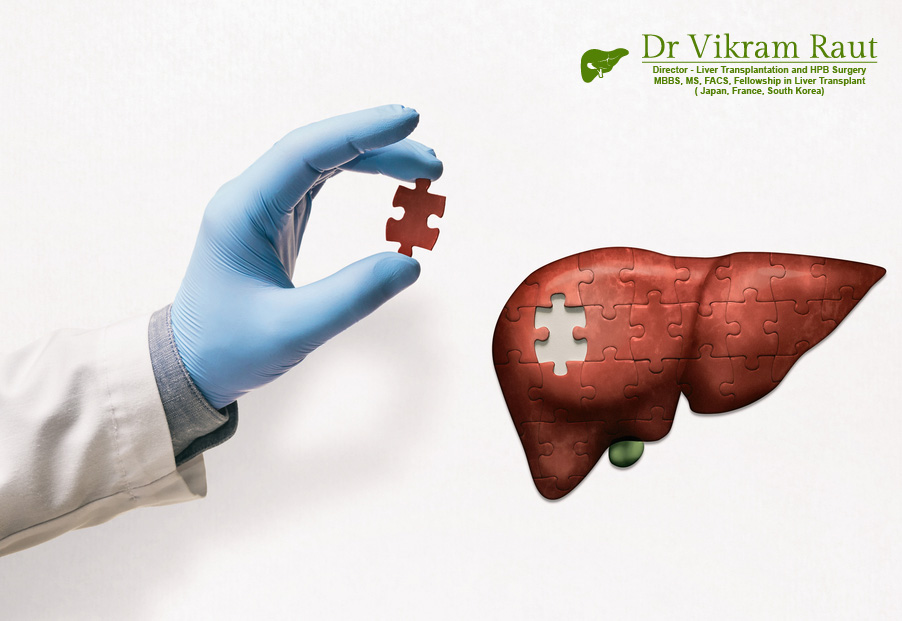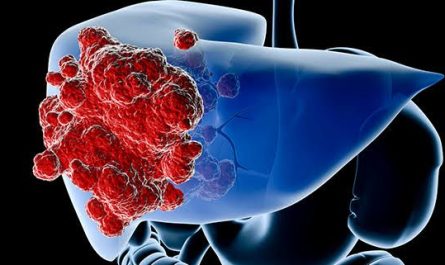Liver transplantation is a surgical procedure that replaces a diseased or injured liver with a healthy liver from another person, called the donor.
Liver transplantation is a treatment option for people who have end-stage liver disease or acute liver failure, which means their liver no longer functions properly. The most common cause of end-stage liver disease is cirrhosis, which is scarring of the liver due to various conditions, such as hepatitis, alcohol abuse, or fatty liver disease.
There are two main types of liver transplantation:
1. Orthotopic transplantation
Orthotopic transplantation involves removing the entire diseased liver and replacing it with a whole liver from a deceased donor.
2. Living-donor transplantation
Living-donor transplantation involves removing a portion of a healthy liver from a living donor (usually a relative or friend) and implanting it into the recipient. The remaining liver in both the donor and the recipient can regenerate and grow back to its normal size.
Liver transplantation is a complex and risky surgery that requires careful evaluation of the recipient and the donor, as well as lifelong follow-up and medication to prevent rejection of the new liver. The availability of donor organs is also a major limitation for this procedure. However, for some people with life-threatening liver conditions, liver transplantation can offer a chance for survival and improved quality of life.
Causes of liver transplantation

The causes of liver transplant in adults are the conditions that lead to liver failure or liver cancer that cannot be treated with other therapies. Liver failure can be acute (sudden) or chronic (long-term), and it means that the liver no longer functions adequately to perform its vital roles in the body. Liver cancer can be primary (originating in the liver) or secondary (spreading to the liver from another site), and it can affect the liver function and cause symptoms.
The common causes of liver transplant in adults are:
Hepatitis C, which is a viral infection that causes inflammation and scarring of the liver. Chronic hepatitis C can lead to cirrhosis, liver failure, or hepatocellular carcinoma (HCC), which is the most common type of primary liver cancer.
Alcoholic liver disease, which is caused by excessive alcohol consumption over a long period of time. It can cause fatty liver, alcoholic hepatitis, cirrhosis, liver failure, or HCC.
Nonalcoholic fatty liver disease (NAFLD), which is a type of fatty liver disease that is not related to alcohol use. It is associated with obesity, diabetes, high cholesterol, and metabolic syndrome. It can cause inflammation, fibrosis, cirrhosis, liver failure, or HCC.
Primary sclerosing cholangitis (PSC), which is a chronic inflammatory disease that affects the bile ducts inside and outside the liver. It can cause narrowing or blockage of the bile ducts, leading to cholestasis, cirrhosis, liver failure, or cholangiocarcinoma (CCA), which is a type of cancer that arises from the bile ducts.
Primary biliary cholangitis (PBC), which is a chronic autoimmune disease that causes destruction of the small bile ducts in the liver. It can cause cholestasis, cirrhosis, liver failure, or HCC.
Autoimmune hepatitis, which is a chronic inflammatory disease that causes the immune system to attack the liver cells. It can cause cirrhosis, liver failure, or HCC.
Hepatocellular carcinoma (HCC), which is a type of primary liver cancer that originates in the liver cells. It can be caused by various factors, such as chronic hepatitis B or C, cirrhosis, alcohol abuse, NAFLD, or exposure to toxins. It can affect the liver function and cause symptoms such as abdominal pain, weight loss, jaundice, or ascites.
Cholangiocarcinoma (CCA), which is a type of primary liver cancer that originates in the bile ducts. It can be caused by various factors, such as PSC, chronic hepatitis B or C, cirrhosis, parasitic infections, or exposure to toxins. It can affect the bile flow and cause symptoms such as jaundice, itching, abdominal pain, weight loss, or fever.
Acute hepatic fulminant failure, which is a sudden and severe impairment of liver function due to various causes, such as viral hepatitis, drug toxicity
Common causes of liver transplant in children

Biliary atresia, which is a rare congenital condition that causes obstruction or absence of the bile ducts that drain bile from the liver to the intestine. This can lead to cirrhosis, portal hypertension, and liver failure in infants and children. It is the most common cause of liver transplant in children.
Inborn errors of metabolism, which are genetic disorders that affect the metabolism of certain substances in the liver. Examples include alpha-1 antitrypsin deficiency, Crigler-Najjar syndrome, Byler’s disease, glycogen storage disease, Wilson’s disease, hemochromatosis, tyrosinemia, Wolman’s disease, familial amyloidotic polyneuropathy, and primary hyperoxaluria type 1. These conditions can cause liver damage, cirrhosis, liver failure, or neurological complications.
Hepatitis B or C, which are viral infections that cause inflammation and scarring of the liver. Chronic hepatitis B or C can lead to cirrhosis, liver failure, or hepatocellular carcinoma (HCC), which is the most common type of primary liver cancer.
Autoimmune hepatitis, which is a chronic inflammatory disease that causes the immune system to attack the liver cells. It can cause cirrhosis, liver failure, or HCC.
Alagille syndrome, which is a genetic disorder that affects the development of the bile ducts and other organs. It can cause cholestasis, cirrhosis, liver failure, or HCC.
Hepatocellular carcinoma (HCC), which is a type of primary liver cancer that originates in the liver cells. It can be caused by various factors, such as chronic hepatitis B or C, cirrhosis, biliary atresia, or exposure to toxins. It can affect the liver function and cause symptoms such as abdominal pain, weight loss, jaundice, or ascites.
Acute hepatic fulminant failure, which is a sudden and severe impairment of liver function due to various causes, such as viral hepatitis, drug toxicity
Recovery after liver transplantation
The recovery time after a liver transplant can vary depending on the individual and the type of transplant, but it usually takes several months before you can resume normal activities and feel fully healed. You may be able to start gradually building up your activities after a few weeks, but you will need regular check-ups and blood tests to monitor your new liver and prevent complications.
The average hospital stay for a liver transplant recipient is about 2 weeks, but it may be longer if there are any problems or infections. After leaving the hospital, you will need a caregiver to help you with daily tasks and medications for the first few weeks or months. You will also need to take immunosuppressants for the rest of your life to prevent your body from rejecting the new liver. These medications can have side effects, such as high blood pressure, diabetes, or infections, so you may need other medications to manage them.
The liver has the ability to regenerate and grow back to its normal size after surgery. Both the recipient and the donor’s liver will almost completely regenerate within 8 weeks. However, this does not mean that the liver function will be fully restored by then. It may take longer for the liver to adjust to its new environment and perform all its functions properly.
Recovering from a liver transplant can be challenging, but it can also offer a chance for improved quality of life and survival for people with life-threatening liver conditions. It is important to follow your doctor’s advice and take good care of yourself and your new liver.
Complications after liver transplantation
Some of the common complications after liver transplantation are:
1. Rejection of the donated liver by your immune system, which can cause inflammation and damage to the new liver. You will need to take immunosuppressant medications for life to prevent this, but sometimes rejection can still occur and require additional treatment.
2. Infection of the new liver or other parts of your body, due to the weakened immune system caused by the immunosuppressant medications. You will need to take antibiotics and antifungal medications to prevent or treat infections, and avoid exposure to people who are sick or sources of infection.
3. Bleeding or blood clots in the blood vessels that connect the new liver to your body. This can cause reduced blood flow to the new liver or other organs, and may require surgery or other procedures to fix.
4. Bile duct complications, such as leaks or narrowing (stenosis) of the bile ducts that carry bile from the new liver to your intestine. This can cause bile to back up into the new liver or leak into your abdomen, and may require surgery or other procedures to fix.
5. Failure of the donated liver to function properly, either due to rejection, infection, blood clots, or other reasons. This can cause symptoms of liver failure, such as jaundice, confusion, swelling, or bleeding. You may need another liver transplant if this happens.
6. Malignancy (cancer) of the new liver or other parts of your body, due to the increased risk of cancer caused by the immunosuppressant medications. You will need to have regular screening tests and check-ups to detect and treat any cancers early.
7. Side effects of the immunosuppressant medications, such as high blood pressure, diabetes, kidney problems, osteoporosis, mood changes, weight gain, or infections. You may need other medications to manage these side effects.
These complications can be serious and sometimes life-threatening, but they can also be prevented or treated if detected early. It is important to follow your doctor’s instructions and report any symptoms or problems you have after your liver transplant.
The success of liver transplantation
The success rate of liver transplantation depends on various factors, such as the cause of liver failure, the type of transplant, the age and health of the recipient, the quality of the donor liver, and the occurrence of complications. However, in general, liver transplantation is a life-saving and effective treatment for people with end-stage liver disease or liver cancer.
According to the Scientific Registry of Transplant Recipients, the national average survival rates for liver transplant recipients in the United States are:
One year: 88.4%
Three years: 79.8%
Five years: 73.6%
Ten years: 64%
Fifteen years: 56%
Twenty years: 52%
The success rate of liver transplantation may vary depending on the specific transplant center and the individual recipient’s condition. Therefore, it is important to discuss your prognosis and expectations with your transplant team before and after the surgery.
How is life after liver transplant surgery?
Life after liver transplantation can be challenging, but also rewarding. It can offer a chance for improved quality of life and survival for people with end-stage liver disease or liver cancer. However, it also requires lifelong care and commitment to follow the medical advice and take good care of the new liver.
Some of the aspects of life after liver transplantation are:
Medications: You will need to take immunosuppressants for the rest of your life to prevent your body from rejecting the new liver. These medications can have side effects, such as high blood pressure, diabetes, kidney problems, osteoporosis, mood changes, weight gain, or infections. You may need other medications to manage these side effects. You will also need to take antibiotics and antifungal medications to prevent or treat infections, and avoid exposure to people who are sick or sources of infection. You will need to have regular blood tests to check your immunosuppressant levels and adjust the doses if needed.
Recovery: The recovery time after a liver transplant can vary depending on the individual and the type of transplant, but it usually takes several months before you can resume normal activities and feel fully healed. You may be able to start gradually building up your activities after a few weeks, but you will need regular check-ups and blood tests to monitor your new liver and prevent complications. You will also need a caregiver to help you with daily tasks and medications for the first few weeks or months. You will also need to take precautions to avoid injury or infection of your surgical site.
Diet: You will need to follow a healthy and balanced diet that includes lean meats, poultry, fish, fruits, vegetables, and whole grains. You will need to avoid raw or undercooked foods, unpasteurized dairy products, and grapefruit or grapefruit juice, as they can interfere with your medications or cause infections. You will also need to stay hydrated by drinking adequate water and other fluids each day. You will need to avoid alcohol and limit caffeine intake, as they can harm your new liver or interact with your medications.
Exercise: You will need to follow an exercise program that is suitable for your condition and approved by your doctor. You will need to start gradually and increase your activity level as you recover. Exercise can help improve your blood circulation, muscle strength, mood, and overall health. You will need to avoid contact sports or activities that may injure your abdomen or new liver.
Skin care: You will need to protect your skin from sun damage and skin cancer by using sunscreen, wearing hats and sunglasses, and avoiding tanning beds. You will also need to check your skin regularly for any changes or growths and report them to your doctor.
Mental health: You may experience emotional changes after a liver transplant, such as anxiety, depression, guilt, anger, or gratitude. You may also face challenges with adjusting to your new life, coping with side effects or complications, or dealing with financial or social issues. You may need to seek emotional support from your family, friends, or a counselor if needed. You may also join a support group for liver transplant recipients to share your experiences and learn from others.
Survival: The survival rate after a liver transplant depends on various factors, such as the cause of liver failure, the type of transplant, the age and health of the recipient, the quality of the donor liver, and the occurrence of complications or rejection. However, in general, liver transplantation is a life-saving and effective treatment for people with end-stage liver disease or liver cancer. According to various sources, the survival rates after a liver transplant are:
Life after liver transplantation can be challenging, but also rewarding. It can offer a chance for improved quality of life and survival for people with end-stage liver disease or liver cancer. However, it also requires lifelong care and commitment to follow the medical advice and take good care of the new liver.
steps to prevent or reduce the risk of complications after liver transplantation
There are some steps you can take to prevent or reduce the risk of complications after liver transplantation:
- Taking your immunosuppressant medications as prescribed and following your doctor’s instructions on how to adjust the doses if needed. You should not stop or change your medications without consulting your doctor, as this can increase the risk of rejection or infection.
2. Taking your antibiotics and antifungal medications as prescribed and completing the full course of treatment. You should also report any signs of infection, such as fever, chills, cough, sore throat, or wound drainage, to your doctor as soon as possible.
3. Following food safety guidelines and eating a balanced diet that includes lean meats, poultry, fish, fruits, vegetables, and whole grains. You should avoid raw or undercooked foods, unpasteurized dairy products, and grapefruit or grapefruit juice, as they can interfere with your medications or cause infections.
4. Staying hydrated by drinking adequate water and other fluids each day. You should avoid alcohol and limit caffeine intake, as they can harm your new liver or interact with your medications.
5. Avoiding exposure to people who are sick or sources of infection, such as certain occupational exposures, or gardening without gloves. You should also wash your hands regularly and use hand sanitizer when needed. You do not need to wear masks after you return home, unless advised by your doctor.
6. Having regular screening tests and check-ups to monitor your new liver function and detect any complications early. You should also have blood tests to check your immunosuppressant levels and adjust the doses if needed. You should report any symptoms or problems you have after your liver transplant to your doctor promptly.
7. Protecting your skin from sun damage and skin cancer by using sunscreen, wearing hats and sunglasses, and avoiding tanning beds. You should also check your skin regularly for any changes or growths and report them to your doctor.
8. Following an exercise program that is suitable for your condition and approved by your doctor. You should start gradually and increase your activity level as you recover. Exercise can help improve your blood circulation, muscle strength, mood, and overall health.
Avoiding stress and seeking emotional support from your family, friends, or a counselor if needed. Stress can affect your immune system and mental health. You may also join a support group for liver transplant recipients to share your experiences and learn from others.


